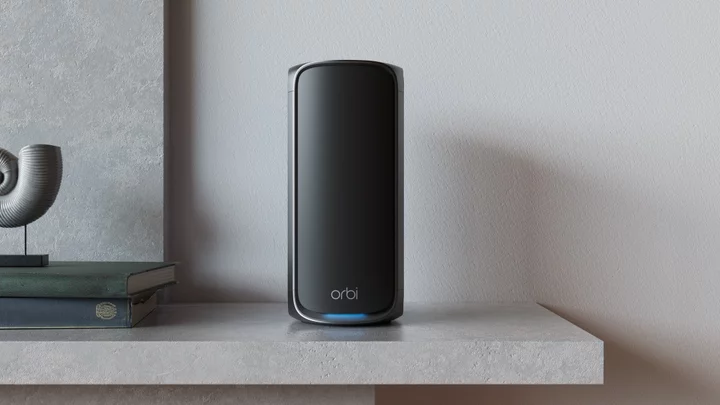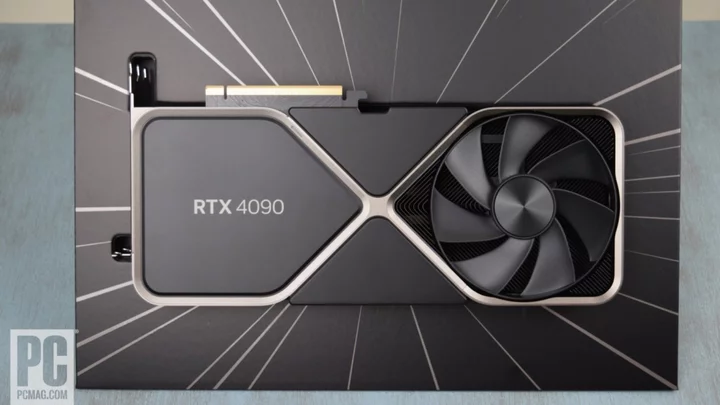The Netgear Orbi 970 Series stands out for several reasons. It’s not only one of the first Wi-Fi 7 mesh systems available, but it delivers the fastest throughput performance among them. At $2,299.99 for the three-node version we tested, it is also easily the most expensive consumer mesh system we’ve come across, Wi-Fi 7 or otherwise. Designed for homes of up to 10,000 square feet, the Orbi is a quad-band system that comes with Netgear’s Armor network security software. It's loaded with top-shelf components like 10GbE and 2.5GbE networking ports and high-performance amplified antennas. Considering the current lack of available Wi-Fi 7 clients, though, we see no urgent reason to run out and buy it. (The same goes for our Editors' Choice winner in this category, the Eero Max 7.) That is, unless you want the biggest, fastest, and most expensive mesh setup on the block.
Design: Your Choice of Black or White
We're reviewing the $2,299.99 Orbi RBE973S here, which is the three-piece system. If you have a smaller home, the two-piece RBE972S system covers 6,600 square feet and goes for $1,699.99. Individual add-on satellites add 3,300 square feet of coverage and cost $899.99 each.
The nodes come in white with gold trim, or black with black trim, and they're truly massive by Wi-Fi mesh standards. They stand 11.5 inches high, 5.6 inches wide, and 5.1 inches deep. The router node is equipped with a 10GbE WAN port, a 10GbE LAN port, and four 2.5GbE LAN ports, all of which can be found on the rear panel along with a Sync (Wi-Fi Protected Setup, or WPS) button, a power button, a power port, and a reset button. Unlike the TP-Link Deco BE85, this mesh system offers no USB ports.
(Credit: Netgear)The base holds an LED indicator that is solid green when the router is powered up and working correctly, blinks red if the firmware is corrupt, is solid magenta when the router has lost its internet connection, and pulses white when the Sync button has been pressed.
The satellite nodes are equipped with a 10GbE LAN port (which can be used for wired backhaul), two 2.5GbE LAN ports, a Sync button for pairing the satellite with the router, a reset button, a power button, and a power port. The LED pulses white when the satellite is powering up, is solid blue when it is connected to the router with a good connection, is solid amber when the connection is fair, and is solid magenta if it's not connected to the router.
(Credit: Netgear)Each node is outfitted with 12 high-gain amplified antennas, a 2.2GHz quad-core CPU, 4GB of flash memory, and 2GB of RAM. This is a quad-band BE27000 system, which means that it can hit maximum theoretical data rates of up to 1,147Mbps on the 2.4GHz band, up to 8,647Mbps on one 5GHz band, up to 5,765Mbps on the second 5GHz band, and up to 11,530Mbps on the 6GHz band. That's a total of approximately 27,000Mbps. The 6GHz band and the second 5GHz band can both be used for enhanced dedicated wireless backhaul should your home setup be unable to accommodate wired backhaul.
The RBE973S uses the latest Wi-Fi 7 technology. It supports Multi Link Operation (MLO), which uses the 5GHz and 6GHz bands at the same time to reduce congestion and provide optimal throughput. MLO is one of the key benefits of Wi-Fi 7 over previous Wi-Fi versions, but it requires client support, which is scarce at this point, so it won't be usable right away. Other technology includes MU-MIMO simultaneous data streaming, 320MHz channel bandwidth, 4K QAM, direct-to-client beamforming, WPA3 encryption, and orthogonal frequency-division multiple access (OFDMA) transmissions.
The Orbi also comes with a free one-year subscription to Netgear’s Armor security software, which protects your network and all connected devices from viruses, password theft, ransomware, and other security threats. Once the free trial ends, you’ll have to pay $99.99 per year to renew the subscription. You also get free basic parental controls that let you create profiles, pause internet access, and manage online time for family members, but you’ll need a $7.99 monthly/$69.99 yearly Premium subscription to unlock features such as age-based web filtering, website monitoring, device usage stats, and time rewards for good behavior.
(Credit: Netgear)You can control the Orbi with the same mobile app for iOS and Android devices that many other Netgear products use, including the Orbi RBKE963 WiFi 6E Mesh System. Or, you can use the web-based console, which offers a few extra settings that let you do things like configure a separate IoT network for smart home devices and configure a VPN.
The mobile app makes it easy to control the Orbi mesh network using your phone. It opens to a dashboard screen with an image of the router node and its status (online or offline, as well as the number of connected satellite nodes). You can tap the router image to view a network map showing each node. When you tap a node, you can see which clients are connected to it, and when you tap a client you can see which band it is using, its link rate, and its IP address.
(Credit: Netgear)Below the router image are tiles that allow you to view online device information, view Armor security information (potential threats and remedies), configure Wi-Fi settings, assign parental controls, create a guest network, monitor network traffic, and run a speed test.
Testing the Orbi 970 Series: Multi-Gigabit Wi-Fi for the Win
As with most other mesh systems, the Orbi is easy to install. I started by downloading the mobile app and creating an account. Next, I tapped Set up an Orbi. I scanned the QR code on the base of the router node, unplugged my modem, and connected the Orbi router to my modem via the 10Gbe WAN port. I powered up the modem and the router, verified that the modem LED was steady, and waited close to five minutes for the router LED to turn solid white, at which point I tapped Continue. I allowed my phone to join the Orbi network and gave the new network a name and a Wi-Fi password. I then waited a few minutes while the app saved my information and created the network. The app verified that my firmware was up to date, so I tapped Next and plugged in the satellite nodes. Within a few minutes they were added to the network and the installation was complete.
The RBE973S performed brilliantly on our throughput performance tests. The router node delivered 2,209Mbps on the close-proximity test and 916Mbps on the 30-foot test, while the satellite node delivered 1,470Mbps on the close-proximity test and 1,040Mbps on the 30-foot test. You can see how that compares with the other Wi-Fi 7 mesh systems we've tested so far in the chart below. Its router node easily led the pack on both tests, while its satellite node is competitive but not class-leading.
We use an Ekahau Sidekick 2 diagnostic device and Ekahau's Survey software to test wireless signal strength. (Note: Ekahau is owned by PCMag publisher Ziff Davis). This combination generates heat maps that show the router's signal strength throughout our test home. The circles represent the location of the router and the satellite node, and the colors represent signal strength, with dark greens representing the strongest signal and lighter yellow areas representing a weaker signal. Gray areas indicate very weak or no measurable signal reception.
(Credit: Ekahau)As shown on the map, the RBE973S had no trouble delivering relatively strong Wi-Fi to every corner of our test home.
Verdict: Future Proofing Will Cost You
Blazing performance, future-proof technology, and a wealth of high-speed networking ports are all good reasons to consider the Netgear Orbi 970 Series if you’re looking to upgrade your home network. The three-piece RBE973S mesh system offers excellent coverage, employing four radio bands and Wi-Fi 7 tech to provide the fastest throughput speeds we’ve seen. It also comes with parental control and network security software, even though you’ll have to pay extra to take full advantage of both.
That said, the $2,299.99 price is hard to justify considering the lack of available Wi-Fi 7 clients out there. If you require a mesh system that supports 6GHz transmissions but don't care about living life on the bleeding edge of Wi-Fi 7, you’ll save a bundle with the $273.99 Wyze Wi-Fi 6E Mesh Router Pro system. It doesn’t use Wi-Fi 7 technology, but it delivers speedy throughput and is equipped with multi-gig networking and USB ports.
Meanwhile, if you must have Wi-Fi 7, also consider the Eero Max 7. In addition to being slightly cheaper and equally easy to set up, it also offers more-robust support for home automation.









